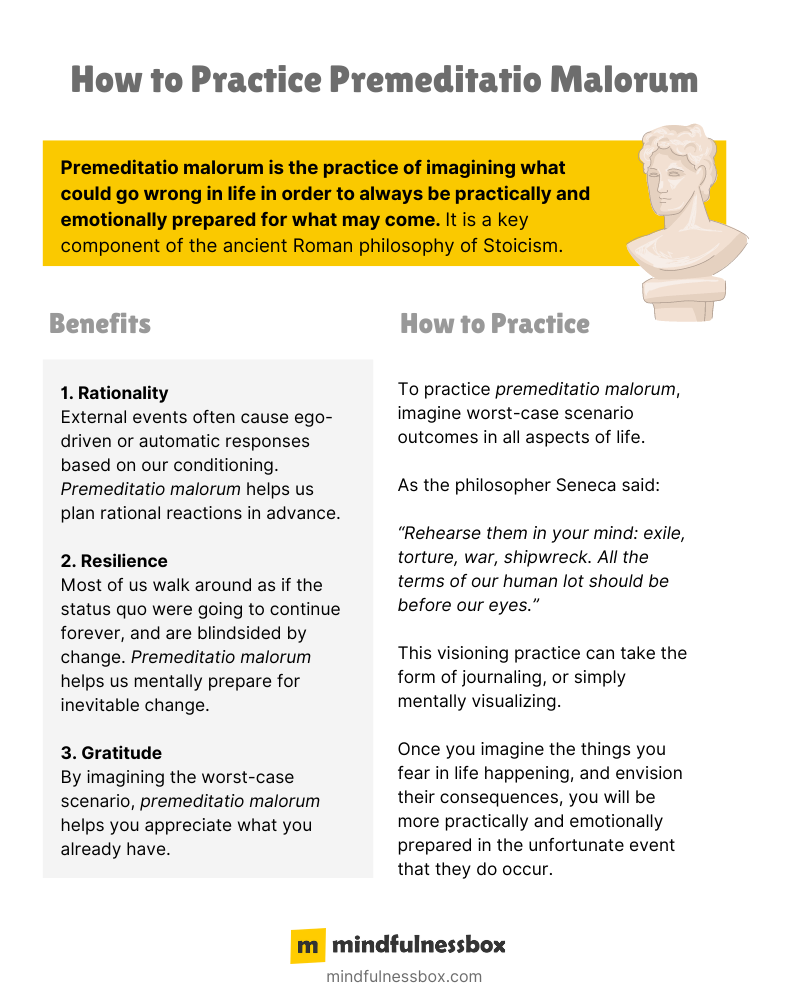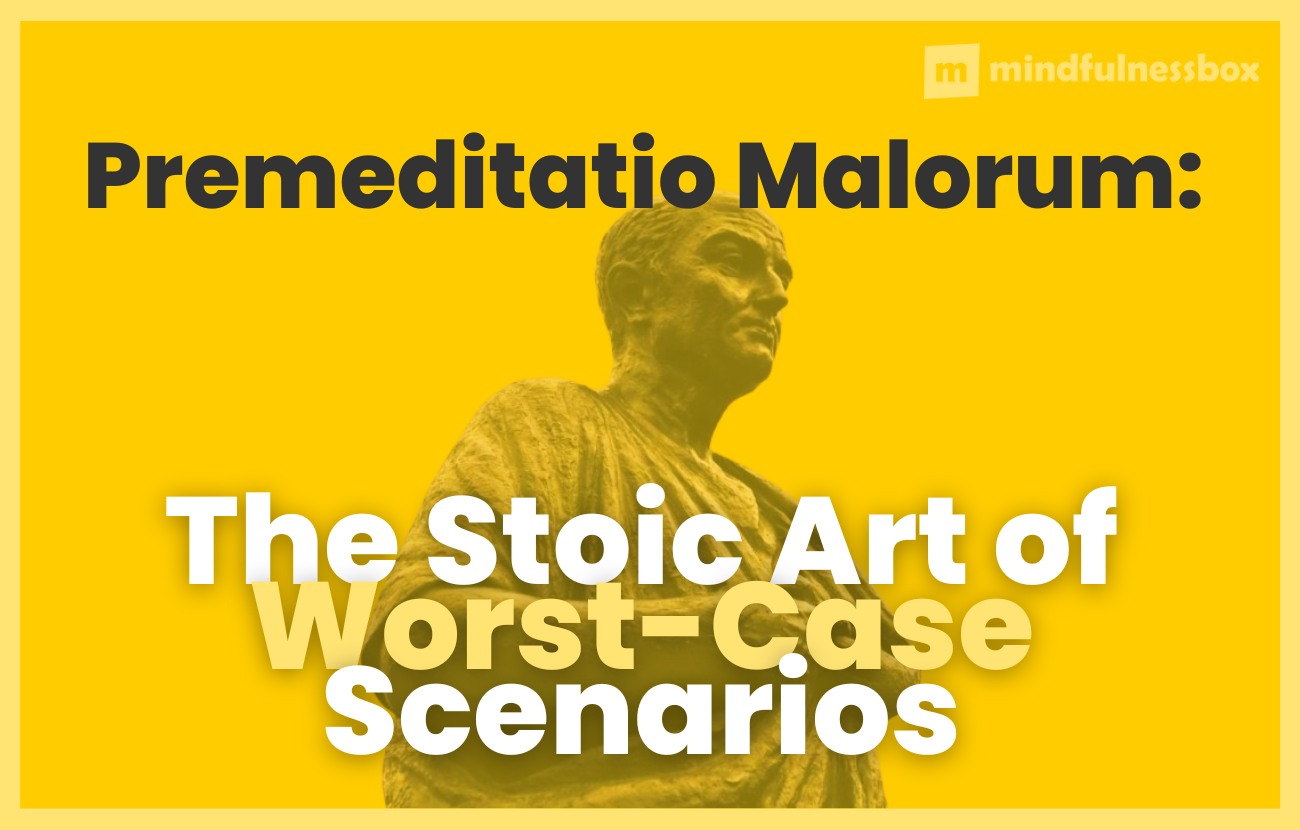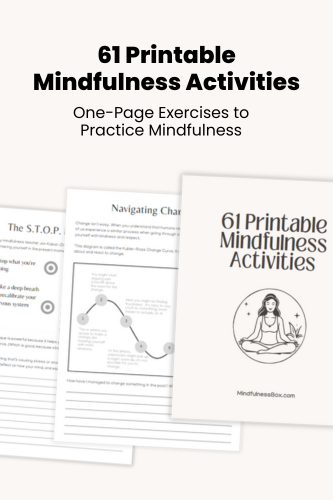Premeditatio malorum is the practice of visualizing what could go wrong in life in order to be practically and emotionally prepared for what may come. It is a key component of the ancient Roman philosophy of Stoicism.
According to the Stoics of ancient Rome, by shielding yourself from the horrible things that may happen in life, you’re doing yourself a disservice.
“Rehearse them in your mind: exile, torture, war, shipwreck. All the terms of our human lot should be before our eyes.”
– SenecaInstant Download61 Printable Mindfulness Activities$19.00Buy Now Learn MoreGet dozens of one-page exercises to help practice mindfulness, meditation, gratitude, and self love. Perfect for printable handouts when teaching mindfulness to groups, students, or in the workplace.
To see examples, plus a full list of the 61 exercises included, click below.
The Stoics made a habit of imagining all the problems that might arise in the future.
Through negative visualization exercises, they found themselves able to respond more rationally in the event that one of these unfortunate scenarios did come to pass.
Responding rationally, not emotionally

In the eyes of the Stoics, the key benefit of premeditatio malorum was its ability to make them more resilient.
Many of the events that happen to us wound us psychologically more than anything else.
When you’re hoping for external events to go a certain way, and then they don’t, the result can be immensely dissatisfying. This is doubly true if your ego was tied to the outcome.
As Seneca, one of the godfathers of Stoicism, said:
“If an evil has been pondered beforehand, the blow is gentle when it comes… Hence, the wise man accustoms himself to coming trouble, lightening by long reflection the evils which others lighten by long endurance.”
There are a couple points of wisdom here:
- Hope for the best, prepare for the worst: Anticipating future negative events can lessen the blow if and when they happen. As the saying goes, “Hope for the best, prepare for the worst.”
- Don’t get blindsided by reality. Hardships often come from adapting to the new reality of a negative event. As Seneca says, we can better endure negative events once we’ve gotten used to them. Premeditatio malorum gives you the chance to dwell on negative events in advance, shortening the time needed to get used to them. Even after difficult life events, we tend to revert to our baseline levels of happiness in a relatively short time.
Gratitude is a side effect of preemeditatio malorum
Let’s say you go through the exercises Seneca recommends above: imagining shipwreck, war, torture, and exile.
Or perhaps a more modern version: loss of your livelihood, home, reputation, or loved ones.
When you truly imagine losing these things, there is an unavoidable side effect:
Gratitude.
Imagining loss leads to gratitude for what you already have.
A short guide to premeditatio malorum

Here’s how premeditatio malorum works:
First, take stock of what you value.
Whether that’s your relationships, your kids, your partner, your home, your lifestyle—start thinking about the things that are most important to you.
Second, imagine these things are taken away from you.
Do this one by one. Start with losing your home, for example. Visualize yourself at some point in the future without it. Perhaps it burned down, or perhaps it was taken away from you in some other way.
Third, imagine the consequences.
Walk through what you’d do then. Get practical. Maybe you’d gather your family and go to a hotel for the first few nights. Visualize the hotel. Then, perhaps you arrange some other kind of short-term housing before finding a longer-term solution.
Fourth, tap into gratitude.
Imagine how you’d feel. Imagine what you’d do to get back to the life you once had. Imagine what you’d trade to simply roll back the clock and go back in time.
Fifth, come back to the present.
Everything you’d imagined losing is now back in your life.
Becoming more resilient through Stoic philosophy
If there’s a single takeaway from this Stoic practice, it’s this:
Don’t avoid thinking about losing the things you hold dear in life.
Instead, imagine them in detail so you can respond rationally if and when something unfortunate does occur—and so you can better appreciate the things you have while you still have them.
Of course, there’s a fine line between imagining worst-case scenarios and giving in to anxiety and worry.
Premeditatio malorum is meant to be an exercise, not a way of life.
Set aside 5-10 minutes to do a premeditatio malorum session.
Imagine that what you have is gone, imagine the consequences, and imagine what you’d do next.
Then ease yourself back into reality, ready to embrace what you have with renewed gratitude.

My mindfulness practice kicked off in 2016 with a ten-day silent retreat. Since then, I’ve read dozens of books about mindfulness and completed hundreds of hours of meditation. Thinking about what makes humans happy, calm, and peaceful is endlessly fascinating to me.


